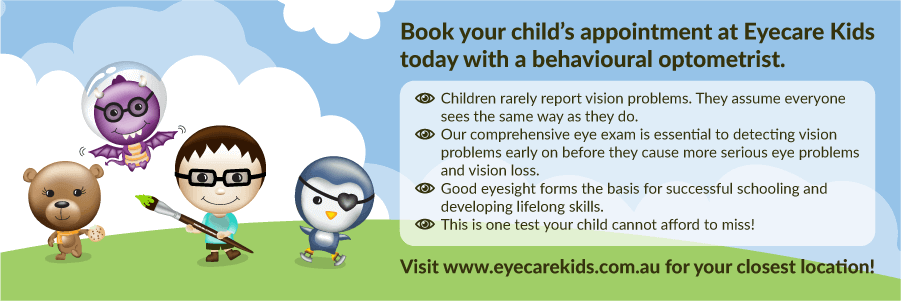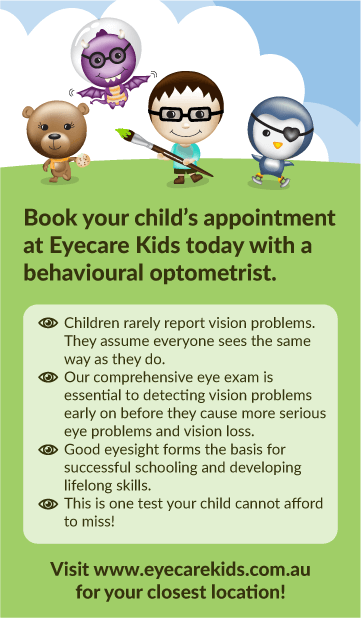We once had a lovely year 6 student, Sam* come in for her first eye test ever. Her parents booked her in for a regular eye exam expecting all the results to be normal. They were being diligent parents for getting all her medical tests done before starting high school. Sam’s eyes were healthy. One eye saw perfectly well with 20/20 sight but the other eye…. well it had a pretty high prescription and its sight was so poor, it couldn’t even see the biggest letter on the chart! It didn’t matter what lens we put in front of the blurry eye, she just could not see clearly. Her parents were shocked! Why didn’t their daughter know she couldn’t see out of the left eye? How could this have happened? Once the shock passed, the parents got upset. Why? Because their daughter had passed a vision screening test in primary school and they assumed that everything was fine all these years. No one recommended a follow-up check up with an optometrist. No one explained that the test she did at school was only a vision screening test and that it didn’t replace an optometric eye exam.
So how did Sam pass her vision screening test?
Sam* probably had a lazy eye for a long time, even before the primary school screening that had ‘passed’ her vision. She probably peaked through her fingers from the covered eye when reading the letter chart and faked good vision out of the ‘blurry’ eye. Hey, we know kids don’t like getting in trouble and she probably thought she would if she couldn’t read the small print! So she read the small print, passed her vision screening and that was the end of it….
Until she saw our optometrist!
In Sam’s mind, she didn’t have a vision problem. Everything she wanted to see clear…. was clear, with both eyes open of course. She could see the distance clearly, and she could see close up clearly. She was a good student and the only problem that could possibly be a problem was that she was a slower reader compared to her friends. The real problem was that when she covered the eye that could see clearly, she was now legally blind. Nothing made things clearer. Not even glasses, even though she had a significant prescription in that blurry eye. This happened because Sam’s brain thought blurry was normal out of that eye because it just never saw clearly from the day she was born. She had a common condition called refractive anisometropia amblyopia which basically means – the prescription is just too different between the two eyes to make both clear – so it ignores the images from one eye and makes it blurry and concentrates on the other eye which makes the world clear.
Sam’s brain basically said, we had a vision problem and I solved it the best way I could… by making one eye lazy so that the other eye makes our world clear.
Amblyopia affects around 3% of the population and in the absence of an ocular pathology, the two most common reasons for this condition is refractive anisometropia and strabismus.
Before we continue, we need to dispel one myth that seems to still float around about amblyopia. Our optometrists still get parents coming in concerned that they may have ‘missed the critical period for correcting a lazy eye’. There IS NO critical period. In recent peer review studies, the authors still mention that despite the fact that amblyopia can help older patients, treatment is rarely offered to children beyond 9 years of age as it was assumed that the visual system lacked the necessary neural plasticity to improve function at this age. For anyone concerned about this, let’s make it clear that there is a considerable body of evidence that suggests the brain possess significant neural plasticity into adulthood. There is no magical age when amblyopia closes the door to being fixed. Sure it’s easier to fix amblyopia in a child but it will also improve in an adult. Even as far back as 2005, PEDIG (Paediatric Eye Disease Investigator Group) in a large scale randomised trial (basically means it was a trustworthy study) with over 500 amblyopic subjects found no difference in the benefits of treatments between groups aged 6-12 and 13-20 years. They concluded that failure to offer treatment to individuals over 7 years of age could potentially deprive them of improved visual function.
You are never too old to receive treatment for amblyopia. Improvements in a lazy eye has been documented well beyond the critical period(s) of development into adulthood’. – Dr Soojin Nam, Behavioural Optometrist
Amblyopia is a true disability in the lazy eye. It’s not just that the vision is blurry for distance. It’s also blurry for near. It has fixation instability, fusional suppression, and poor binocular skills. This can affect school performance and contribute to poor fine motor skills. Having amblyopia means you can’t appreciate the world in 3-D, so this means a 3-D movie look like a 2-D movie. Judging space and distances is more difficult which makes activities like playing sport and driving a car more challenging. There are some jobs/careers that will be affected. Most of all, people who have amblyopia know they have amblyopia and it bothers them, bothers their self-confidence and they also have the worry of potentially losing their good eye vision.
Checking for amblyopia can be done through several tests during an eye exam, Soojin Nam demonstrates one of them in the video below.
The gold standard treatment for treating amblyopia in a young child is still patching based on the PEDIG studies. In infants, patching has been prescribed by ophthalmologists anywhere between 2 hours to 12 hours per day. Patching treats this condition as a monocular problem with its sole purpose to make the blurry eye see more clearly again. But here are some facts that parents should know about patching.
- You need to patch for about 150 hours to get 1 line improvement in vision.. that’s a lot of time patching
- Patching, also known as occlusion therapy, has been around for more than 250 years and is NOT the only treatment available for amblyopia
- When the child is at school, we don’t recommend you patch for more than 2 hours a day and certainly NOT during school hours or during homework times
- For some younger kids, patching can be distressing. After all, you are making their perfectly clear world blurry on purpose. They don’t understand.
- Patching at school can adversely affect social and educational development
- Allergies to the adhesive used on patches can be problematic
- Long periods of occlusion can lead to binocular problems such as reduced stereopsis
You need to take these into consideration when patching, particularly as it will be a long-term treatment in a young child. Remember that not all amblyopic children will achieve normal visual acuity despite everyone’s best efforts.
- 50-85% will improve their vision from amblyopia treatment
- 15-50% won’t improve even after extended treatment
- The risk of recurrence of amblyopia after successful treatment is relatively high with 25% developing amblyopia again within the first year off treatment and in a group of esotropic children, more than 60% needed re-treatment during their 5 year follow up.
So is there a better way? There is a growing body of evidence now confirming what behavioural optometrists have been advocating for decades, that amblyopia is not a monocular problem. Patching only treats the secondary monocular visual deficits but does not directly address the primary binocular deficit. Recent research now views binocular dysfunction as the primary deficit in amblyopia. It means if you treat amblyopia as a 2-eyed problem rather than a 1-eye problem, you are more likely to get faster and more sustained improvements. This is an exciting direction that amblyopia research is heading to.
In the meantime, speak to one of our optometrists to understand the management options available for your child’s amblyopia. Remember that whilst patching is important, it is not the only treatment available. Ask us how vision therapy could help support the development of binocular vision and eliminate amblyopia.


